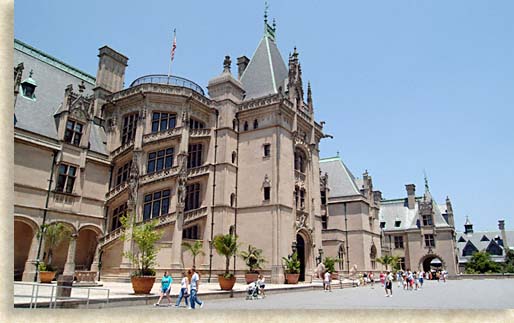During the Depression-era the city of Asheville approached Mr. And Mrs. Cecil with requests to make Biltmore Estates available to the public in order to stimulate the economy with tourism.
The Cecil family proudly opened the Estate to the public in March 1930. In keeping with George’s dream of maintaining the estate as a self-sufficient enterprise the idea of tourism or more appropriately having “guests” at Biltmore Estates would fit nicely with George W. Vanderbilt’s original plan to be a gracious host and a self-sufficient enterprise.
When World War II arrived, the Vanderbilt family pitched in. Our capital was in fear of attack. Priceless artworks from the National Gallery of Art were stored at Biltmore Estate for safekeeping. Quite a risky venture, yet the Gallery was confident that the estate was highly secure, just as it is today.
In 1960 William Cecil left a banking career in New York City, to join his brother George in managing Biltmore Estate. Working under the terms of a trust for their inheritance of the estate, William set about restoring the estate to its “Turn of the Century” splendor and the self-sufficient vision of his grandfather.
The opening of 90 rooms with thousands of original objects was a monumental task that required an ongoing preservation program to maintain the estate, as it was when the founding Vanderbilt's were present.
In 1990 George Cecil converted the dairy into a winery, a winery that is the most visited wine making facility in America.
William A.V. Cecil Jr. the son of William Cecil is the current CEO of Biltmore Estate, continuing on the traditions and wishes of his father and great-grandfather.
Biltmore Estate is and has always been a family owned & managed enterprise and is the largest private owned residence in America.
With a staff of approximately 1,500 personnel, servicing a guest list that exceeds over 1 million annually, Biltmore Estate is the second largest employer in Asheville, North Carolina .
Once the private residence of the Vanderbilt’s and Cecil families, the Biltmore House now reflects a testament to a visionary. What appears to be a castle, now functions as an extraordinary private museum. Guests arrive at the entrance of Biltmore House 364 days a year, coming to witness the wonders within. No cameras are allowed in the House, only with advance permission are the media allowed to photograph the interior of the House. Photographing the grounds and the Biltmore House exterior is permitted to the guests, and make very special memories.
As media guests, Biltmore Estate has allowed the Blue Ridge Highlander, the privilege of bringing to its readers a view of the many treasures within the Biltmore House. It is to their courtesy that we can share our personal experience. With over 250 rooms to cover, we chose a selective tour of some of the more popular sections within the House. There is much more to discover and experience first hand once you decide to tour the grand works of Biltmore Estate for yourself.
Back to the Biltmore Estate Main Page
![]()
Sign
up for the Blue Ridge Highlander Newsletter, Messages from the Mountains
to find out first about our new feature stories, road trips and special offers
Your e-mail addresses will not be sold or given away to anyone.
Privacy
Policy
Interested in your business being on the Highlander, click here...
Let our visitors tell you about the Highlander...
Click the feathers to go to the Highlander site
map...



